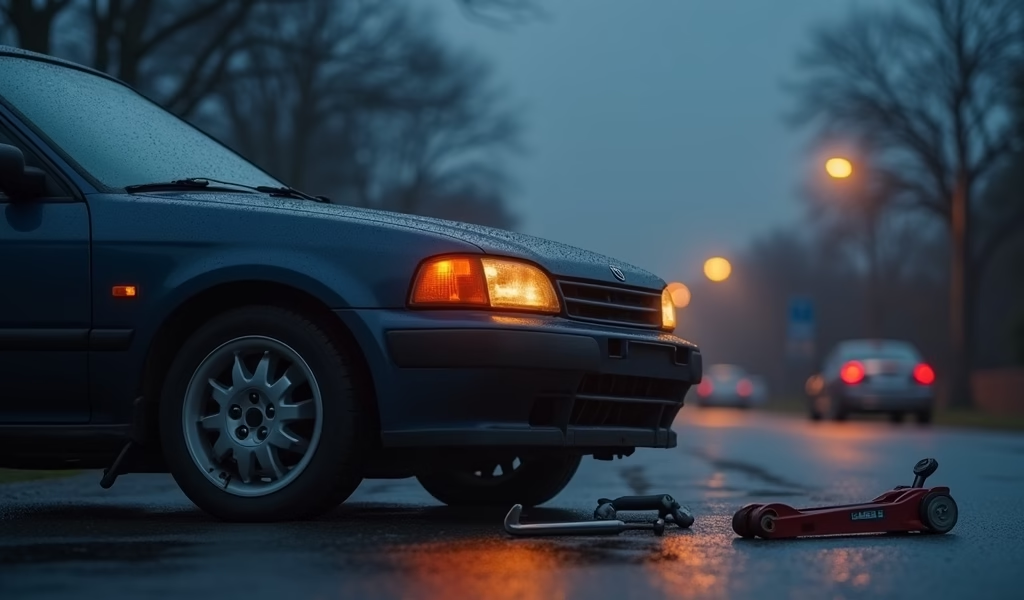Overview
This article explains how proper vehicle maintenance can help teen drivers reduce their high insurance premiums, highlighting five essential practices: regular maintenance, tire care, keeping the vehicle clean, basic troubleshooting skills, and maintaining detailed maintenance documentation. By establishing good car care habits early, teens can demonstrate responsibility to insurance companies, potentially qualify for discounts, and ensure vehicle safety while extending its lifespan.
Table of Contents
- Introduction: The Reality of Teen Car Insurance
- Regular Maintenance: The Foundation of Vehicle Care
- Tire Care: Where Safety Meets Savings
- Keeping It Clean: More Than Just Appearances
- Basic Troubleshooting: Becoming Your Car’s First Responder
- Documentation: Your Maintenance History Matters
- Conclusion: Responsibility Pays Off
- Frequently Asked Questions
Introduction: The Reality of Teen Car Insurance
Getting that first driver’s license is a milestone moment in any teenager’s life – the gateway to independence and freedom. But that freedom comes with a steep price tag: car insurance for teens often costs two to three times more than it does for experienced drivers. This isn’t just an arbitrary penalty for being young – statistics consistently show teen drivers have higher accident rates due to inexperience.
As a mechanic with over 20 years of experience working with young drivers, I’ve seen firsthand how proper vehicle maintenance can significantly impact both safety and insurance costs. Insurance companies notice responsible habits, and many now offer discounts for drivers who demonstrate they care for their vehicles properly.
What many families don’t realize is that proper car maintenance isn’t just about preventing breakdowns – it’s about establishing patterns that can lead to lower insurance premiums over time. According to the Insurance Institute for Highway Safety, vehicles in good mechanical condition are less likely to be involved in accidents, a fact that doesn’t escape insurers’ attention.
Let’s explore five essential car care tips that can help teens become more responsible vehicle owners while potentially reducing those eye-watering insurance premiums.
Regular Maintenance: The Foundation of Vehicle Care
Think of routine maintenance as your car’s version of regular doctor checkups. Skipping them might seem fine in the short term, but the long-term consequences can be severe – and expensive.
Oil changes remain the cornerstone of basic car care. Your engine contains hundreds of moving parts that need proper lubrication to function. Fresh oil prevents these components from grinding against each other and causing catastrophic damage. Most vehicles need an oil change every 3,000-7,500 miles, depending on the manufacturer’s recommendations and driving conditions.
Beyond oil, teens should familiarize themselves with checking and maintaining proper fluid levels:
- Coolant/antifreeze – prevents overheating and freezing
- Brake fluid – ensures your stopping power stays consistent
- Power steering fluid – maintains smooth, responsive steering
- Transmission fluid – keeps your gears shifting properly
- Windshield washer fluid – maintains visibility in all conditions
I once had a teenage customer who ignored her car’s maintenance schedule for nearly two years. When she finally brought it in, the engine was running on oil that had degraded to the consistency of sludge. The repair bill was over $2,500 – enough to cover about 80 oil changes. That’s a harsh lesson, especially when you’re already paying premium insurance rates.
Setting calendar reminders for maintenance milestones can help teens stay on track. Many maintenance tracking apps are available that make this process even simpler by sending notifications when service is due based on your mileage.

Tire Care: Where Safety Meets Savings
Your tires are literally where the rubber meets the road – they’re the only parts of your car that actually touch the pavement. This makes them critical for both safety and performance, two factors that directly impact insurance risk assessment.
Proper tire pressure is something I wish every teen driver understood better. Underinflated tires don’t just wear out faster; they reduce fuel efficiency and compromise handling in emergency situations. Most vehicles have a sticker inside the driver’s door jamb that lists the recommended pressure (measured in PSI). This number often differs from what’s printed on the tire sidewall, which can cause confusion.
A quality tire pressure gauge costs less than $10 and can save hundreds in premature tire wear. I recommend checking pressure at least monthly and before any long trips. Remember that temperature changes affect tire pressure – typically dropping 1-2 PSI for every 10°F decrease in temperature.
Tire rotation ensures even wear across all four tires, extending their lifespan significantly. Most manufacturers recommend rotation every 5,000-7,500 miles. The pattern depends on whether your vehicle is front-wheel, rear-wheel, or all-wheel drive.
Don’t forget to check tread depth regularly. The classic penny test works well: insert a penny with Lincoln’s head upside down into the tread groove. If you can see all of Lincoln’s head, your tread is worn below the safe minimum of 2/32 inch, and it’s time for new tires.
Insurance companies take tire condition seriously because tires in good condition provide better traction on wet roads and reduce stopping distances. Some insurers even offer specific discounts for vehicles equipped with premium safety-rated tires or those that show records of regular rotation and alignment.
Keeping It Clean: More Than Just Appearances
A clean car isn’t just about looking good in the school parking lot – it’s about preserving your vehicle’s value and functionality. Regular cleaning protects both exterior and interior components from premature wear and damage.
Road salt, bird droppings, and tree sap might seem like minor annoyances, but they can cause serious and permanent damage to your paint if left unaddressed. These substances are acidic and can eat through clear coat and paint over time, leading to rust and corrosion. A thorough exterior wash every two weeks is ideal, with special attention after driving through harsh conditions.
The undercarriage deserves special attention, especially in regions where road salt is used during winter. Many car washes offer undercarriage spray options, which are well worth the extra couple of dollars to prevent rust from taking hold.
Inside the vehicle, regular cleaning prevents buildup that can damage components and create distractions. Crumbs and spills aren’t just unsightly – they can work their way into seat mechanisms, clog air vents, and even interfere with electronic components if left unaddressed.
A basic cleaning schedule that works well for teen drivers includes:
- Weekly: Quick interior wipe-down and trash removal
- Bi-weekly: Thorough exterior wash
- Monthly: Detailed interior cleaning including vacuuming, window cleaning, and dashboard conditioning
- Seasonally: Deep cleaning including upholstery treatment and exterior waxing
While insurance companies may not directly reward cleanliness with discounts, a well-maintained vehicle preserves its value better and demonstrates the kind of responsibility that often correlates with safer driving habits. Plus, during claims adjustments, a well-maintained vehicle generally receives more favorable valuations.
Basic Troubleshooting: Becoming Your Car’s First Responder
For many teens, a dashboard warning light might as well be written in hieroglyphics. Developing basic diagnostic skills can transform that moment of panic into confident problem-solving – and potentially prevent small issues from becoming major repairs.
Start by thoroughly reading your owner’s manual. This often-ignored book is actually the most valuable resource for understanding your specific vehicle. It explains what each warning light means and outlines appropriate responses, which can range from “stop driving immediately” to “schedule service at your convenience.”
Some basic troubleshooting skills every teen should develop include:
- Understanding the difference between urgent warning lights (like oil pressure or temperature) and those that can wait for scheduled service
- Checking and replacing fuses for non-functioning electrical components
- Safely jump-starting a dead battery
- Inspecting belts for wear and proper tension
- Using a basic code reader to interpret check engine warnings
Not every issue requires professional attention. Learning to replace air filters, windshield wipers, and even headlight bulbs can save considerable money over time. However, knowing when to call in the experts is equally important. As a rule of thumb, anything involving safety systems, major engine components, or complex electronic systems usually warrants professional attention.
A basic emergency kit for teen drivers should include:
- Tire pressure gauge
- Jumper cables
- Flashlight with extra batteries
- Basic screwdriver set
- Adjustable wrench
- Owner’s manual
- Roadside assistance contact information
Some insurance providers offer specific discounts for vehicles equipped with roadside assistance kits or for drivers who complete basic car care courses. Even without formal discounts, the ability to handle minor issues prevents being stranded in potentially dangerous situations, which certainly impacts overall risk.

Documentation: Your Maintenance History Matters
In my decades as a mechanic, I’ve seen countless customers struggle to remember when they last had their oil changed or tires rotated. For teens just beginning their driving journey, establishing good documentation habits from the start pays enormous dividends.
Think of maintenance records as your car’s medical history – they tell the story of how well it’s been cared for throughout its life. This documentation becomes particularly valuable when dealing with low car insurance companies that offer maintenance-based discounts.
Creating a simple maintenance log doesn’t require anything fancy. A dedicated notebook in your glove compartment works perfectly well. For each service, record:
- Date of service
- Current mileage
- Services performed
- Parts replaced
- Shop or technician name
- Cost of service
Keep all receipts and service records organized in a folder at home. These documents serve multiple purposes:
- Validating warranty claims if components fail prematurely
- Providing proof of maintenance for insurance purposes
- Increasing resale value by demonstrating meticulous care
- Tracking recurring issues that might indicate larger problems
- Creating a reliable timeline for future service scheduling
In today’s digital world, numerous apps and tools make maintenance tracking easier than ever. Apps like CARFAX Car Care, MyCarfax, and AUTOsist offer user-friendly interfaces for logging maintenance events, setting reminders for upcoming services, and even storing digital copies of receipts.
When shopping for cars with cheapest insurance, having detailed maintenance records can sometimes make the difference in qualifying for the best rates. Some insurance companies offer specific discounts for vehicles with documented maintenance histories, recognizing that well-maintained vehicles present lower risk profiles.
Conclusion: Responsibility Pays Off
For teens facing the sticker shock of car insurance rates, proper vehicle maintenance represents one of the most effective long-term strategies for managing those costs. The habits established during these early driving years often continue throughout life, creating patterns that insurance companies recognize and reward.
Beyond potential insurance savings, proper car care translates to enhanced safety, increased vehicle longevity, higher resale values, and fewer unexpected breakdowns. These benefits compound over time, making vehicle maintenance one of the smartest investments a young driver can make.
The connection between responsible car care and insurance rates isn’t just theoretical. Many insurance companies now offer usage-based programs that monitor driving habits and maintenance patterns, directly rewarding responsible behavior with lower premiums. Parents can help teens understand this connection by involving them in maintenance decisions and scheduling.
In my years working with young drivers, I’ve consistently seen that those who embrace vehicle care as a fundamental responsibility tend to develop into more confident, capable, and safety-conscious motorists. The pride that comes from properly maintaining your first vehicle often extends to other areas of responsibility.
Remember, insurance companies aren’t charging teens more just because they can – they’re responding to statistical risk. By demonstrating responsibility through proper vehicle maintenance, young drivers can begin to change that risk profile and position themselves for more favorable rates as they gain experience.
The journey to lower insurance premiums starts with the simple act of checking your tire pressure, changing your oil on schedule, and keeping track of your maintenance history. These small steps can lead to significant savings over time while helping ensure that newfound driving freedom doesn’t come with unnecessary financial burden.
Frequently Asked Questions
How much more expensive is car insurance for teens compared to adults?
Teen drivers typically pay 2-3 times more for car insurance than adult drivers. This higher rate reflects statistical data showing teens are more likely to be involved in accidents due to inexperience.
Can maintenance habits really impact my insurance rates?
Yes, many insurance companies offer discounts for vehicles with documented maintenance histories and for drivers who demonstrate responsible care habits. Some usage-based insurance programs directly track maintenance patterns as part of their risk assessment.
How often should teen drivers check their tire pressure?
Tire pressure should be checked at least once monthly and before any long trips. Temperature changes can affect pressure significantly, so more frequent checks during seasonal transitions are recommended.
What’s the minimum amount of car maintenance knowledge a teen driver should have?
At minimum, teen drivers should know how to check tire pressure, verify fluid levels, replace wiper blades, and understand basic dashboard warning lights. They should also know when professional help is needed versus when they can handle an issue themselves.
Are there specific insurance discounts for teen drivers who maintain their vehicles well?
Many insurers offer “good student” discounts that can be enhanced with proof of vehicle maintenance responsibility. Some companies also provide specific discounts for completion of vehicle maintenance courses or for using maintenance tracking apps that share data with the insurer.


Pingback: Teenage Car Insurance: Proven Car Care - knowsyourcar.com